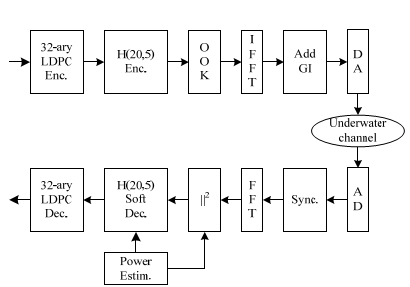Underwater acoustic channel has the characteristics of rapid variation and serious multipath, and accurate estimation of its phase is difficult in adverse condition. Therefore, noncoherent communication, without need of channel phase tracking, is widely used in application of underwater acoustic communication. However, there are seldom research reports in noncoherent underwater acoustic communication in recent years.
In addition, Shannon limited approaching channel codes, for example, LDPC code with iteratively decoding has not been used in noncoherent underwater acoustic communication as we know. The problem of iteratively decoding in noncoherent channel is posterior probability calculation when both channel fading amplitude and phase are unknown.
Nevertheless, the use of constant-weight codes and concatenated codes is a classic technique for noncoherent underwater acoustic communication.
As a result, WU Yanbo, ZHU Min, ZHU Weiqing, XING Zeping, XU Lijun and YANG Bo from the Institute of Acoustics, Chinese Academy of Sciences propose concatenated code based on nonbinary LDPC code and constant weight code in noncoherent communication and iteratively decoded in probability domain.
The system diagram of noncoherent communication scheme based on nonbinary LDPC code is shown in Fig. 1.

Fig. 1. Noncoherent communication based on Nonbinary LDPC code (Image by WU).
Without information of channel amplitude or phase, statistic parameters of signal and noise bins were estimated based on moment estimation method. Besides, posterior probabilities of constant weight code-words were further calculated, and nonbinary LDPC code was decoded with nonbinary sum-product algorithm.
It is verified by simulation that the proposed concatenated code has a 3 dB SNR benefit than non-iterative concatenated code. Underwater communication experiments were carried out in both deep ocean (vertical communication, 5 km) and shallow lake (horizontal communication, near 3 km, delay spread larger than 50 ms). Wherein, signal frequency band was 6~10 kHz, and data transmission rate was 357 bps. It is shown that the proposed scheme can correctly transmit in both experiments with a signal noise ratio of 2 dB.
This research was supported by Chinese National 863 projects 2002AA401004, 2009AA093301 and 2009AA093601.
The research with the title of "Nonbinary LDPC Code for Noncoherent Underwater Acoustic Communication and Its Experiment Results" has been included in the OCEANS ’13 MTS/IEEE San Diego (September 23-26) (130503-011).
Correspondence author:
WU Yanbo, ZHU Min
Institute of Acoustics, Chinese Academy of Sciences, Beijing, China 100190
Email: {wuyanbo,zhumin}@mail.ioa.ac.cn


